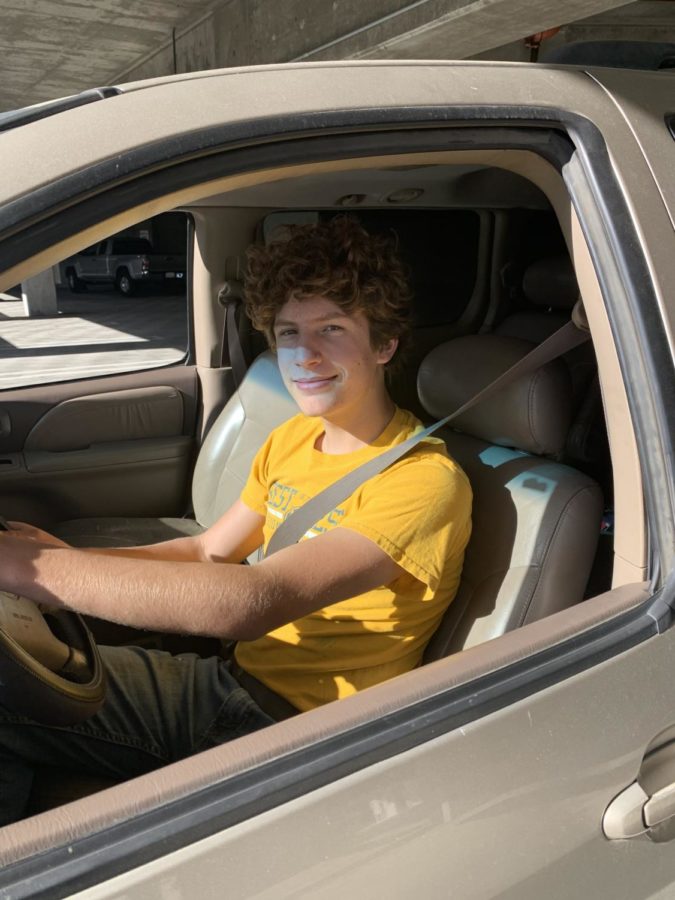PCS Students Get Behind the Wheel
New Drivers Share Experiences
May 23, 2021
I am currently 16 years old, and I’m learning how to drive so I can take myself to sports and other extracurricular events. The complexity of the process made me curious about the driving experiences of other students at PCS, so I decided to interview a few people. Evidently, PCS kids have a variety of reasons for seeking driving licensure. It ranges from just “getting from point A to point B without having to rely on somebody to get me there,”, as sophomore John Wilson puts it, to “[getting] back at a girl that I don’t like because she was excited to get her permit so I wanted to get my driver’s license to rub it in her face,” as another student divulged. There are also common logistical concerns like getting to school. “That way, my parents won’t have to go an hour there, an hour back” says licensed sophomore Jackson Hopkins, a sentiment likely shared by many PCS students who live outside of Santa Cruz city. Getting to work, sports, and meeting up with friends also came up as significant incentives.
Learning to Drive
Most people I talked to practiced their 50 hours of permit driving with a parent, starting from less crowded areas like parking lots and graduating to more heavily-trafficked roads. Marco Panzardi, a freshly licensed 10th-grader, recalls, “whenever we need to go to the supermarket, if it’s far away enough then I’d just be like ‘can I drive?’” For permit practice advice, he adds, “make sure you’re driving with someone who doesn’t stress you out… there have been a couple times when… I did not drive because I was annoyed at my parents.”
I polled folks on the most challenging part of the learning process, and several people mentioned it was simply staying alert and constantly scanning the road. One thing I’ve personally struggled with is paying attention to the speed, especially because you have to keep it within a certain range during the behind-the-wheel exam. Kenzo Miura, a licensed sophomore, recalls the helpful tip that, “I started trying to guess what the speed was, and then I would look at the speedometer.” Speaking of speed, 10th-grader Tori Horobin brings up some advice which would have reassured me quite a bit when I was first driving: “Try not to feel pressured by other drivers if they are upset about you going below the speed limit”. Additionally, many people deemed 41st avenue as a top tricky spot to navigate. “The traffic light is high, but it’s on the other side of the street… so sometimes I don’t see it and I just keep going,” Jackson reflects.
Another complexity was merging, specifically, merging into highways. Sophomore Xander Coomes notes, “after driving on 41st [avenue] became a little simpler, just like merging onto freeways is hard.” In fact, Jackson remembers, “one time… I was going into the freeway, and I was going so slow that the car behind me had to slam on the brakes”.
I have personally been avoiding highway driving, and my parents want my first drive on the highway to be with a professional instructor. Similarly, Ella Skye, a licensed PCS senior, shares, “I didn’t drive on the highway for like, 3 months because I was scared.” Overall though, the consensus was that highway driving is fairly easy. “It’s really not too different,” says Kenzo, and Maddy Ahwal, a newly licensed sophomore, recalls, “just the speeds were maybe a little uneasy at first.” One classmate remarked that in a sense, highway driving is easier than driving on local because there aren’t nearly as many signs and signals to follow. Plus, aside from merging and exiting, you’re mostly just driving straight.
To take the behind-the-wheel test, 10 of your 50 hours of permit practice must be at night. “Night driving, on the one hand it is annoying but on the other hand there aren’t as many cars,” Jackson notes. Ella reflects, “I love driving at night. It feels very free. There’s less people out, and it’s just fun, it’s cold, quiet, it can get lonely sometimes… but it’s fun if you have good music.”
One complexity of night driving is managing high beams. In order to prevent blinding other drivers, according to the 2020 California Driver Handbook, you must dim your lights to low beams within 500 feet of an oncoming vehicle, or within 300 feet of a vehicle you are following. “Sometimes I’ll forget… and then I’ll turn [my high beams] off at the last second” one student admits. However, the California Parent-Teen Training Guide urges new drivers to hold off on night driving until all other skills are mastered, as teen collision risk is highest on weekend nights. So while, according to many interviewees, night driving isn’t something to feel too intimidated about, it’s still critical to always stay alert on the road, even if it’s an empty one.
Another driving complication is rain. The Driver Handbook states that at 50mph or faster in heavy rain, a vehicle may hydroplane, meaning the tires lose all contact with the road. “When it’s pouring really hard, rain driving is so scary… luckily though everybody on the freeway goes like 40 miles an hour” Jackson reflects. Maddy also points out that while rain driving isn’t that bad for her, the water kicked up by the tires of the car ahead can be troublesome.
Another intricacy common for drivers, at least at first, is switching between cars. “I was driving my dad’s Prius for a long time, and when you press down on the gas pedal it doesn’t accelerate very fast… Little to my knowledge, my mom’s gas pedal’s really really reactive, so [when] I was backing out of her driveway the first time, I lightly pressed on the gas pedal and I jolted us backward” Xander remembers. For Ella, who bought her own car shortly after getting her license, “going back to drive my mom’s car when my car broke down was difficult because… [with] my mom’s car… subtle turns of the wheel cause a lot.” “My mom’s car is a 2008 and my car is a ‘89,” she explains. Generally the trend seems that newer cars are more reactive than older ones.
The Tests
Most people I interviewed passed the permit test on the first try, saying it was generally pretty intuitive. “The lady that tells you if you passed… told me I didn’t pass it as a prank,” Ella recalls. Upon asking for study tips, the overwhelming response was to take practice tests online. Tori recommends the ones on the DMV website, and there are several other online practice test sites (just make sure they’re specifically for the California test). It may also be helpful, when selecting a certified driver education course, to look for one that includes many practice tests.
A parent of a friend also advised explicitly requesting to take the permit exam on paper, rather than on the computer as seemed the default for most people I talked to. This is because on most computer tests, you are immediately graded after each question, meaning there’s no going back and forth between questions. They do allow three skips though, which will let you to come back to the skipped question at the end of the test.
As for the behind-the-wheel test, there are certain precautions taken in response to COVID. Everybody has to wear masks, the examiner sits on a plastic seat cover, some people said the examiner put a sheet of paper below their feet, and a few reported that windows had to be down. Regarding the length of the test, everyone said theirs took at most 15 minutes, and often less for COVID safety (not staying in a confined space for too long).
Moreover, Maddy shares that the examiner typically won’t talk to you outside of telling you where to drive to avoid accusations of having distracted the driver. For behind-the-wheel advice, recently licensed sophomore, Maddison Ramsey, recommends exaggerating your head checks – checking your mirrors and over your shoulder – and Xander suggests researching what will be on the test based on your DMV such as the route.
To Drive or Not to Drive
Discussing her motivations to get her license, 10th-grader Molly Gannon mentions, “it’s the social norm, y’know, like there’s kind of an expectation for you to get your driver’s license once you turn a certain age and I kind of feel a little bit of that societal pressure to it”. Which brings up a final point – driving is certainly quite a privilege. There are a great many steps to getting a drivers’ license, which, while necessary for the safety of the road, make for quite a hassle.
For example, you need to present several official documents at the DMV to take the written permit exam. For John, it took him more than a month just to get all of his documents together (Xander recommends asking the PCS registrar, Ms. Barbara Smith, for your two proof of residency documents). It’s also a matter of resources. “I could definitely use [my license] to drive to school, but I don’t know if I’d always have access to the car,” John explains. I also talked to a PCS senior who said their parents simply didn’t have the time to practice driving with them.
Not to mention that driving comes with obvious risk. According to a CDC article, some 2 million people are injured from motor vehicle crashes every year. Tori shared with me that she and her mother were recently rear-ended on highway one (while her mother was driving). “I didn’t know if I wanted to drive again anytime soon, but I realized that it’s my path to having more freedom. There’s always bad drivers on the road, but that’s why you have to be on high alert at all times.”
Clearly, the choice to obtain one’s license warrants significant consideration. Sometimes it’s just not worth it. One student I asked said that they really have no need to drive since they live within walking distance of PCS, and the pandemic makes it so that they wouldn’t be able to meet up with friends anyway. Marco points out that even when all his friends are vaccinated, he wouldn’t be able to drive them for almost a year, as for the first year of licensed driving, minors are not allowed to drive passengers under the age of 25. Maddison corroborates simply, “I don’t think I will use my new ability to drive often because I have no need to be anywhere.”
All of which is to say that, it’s perfectly fine to decide that driving’s not for you right now. And for those who do decide to drive, the very best of luck and safety to you.


